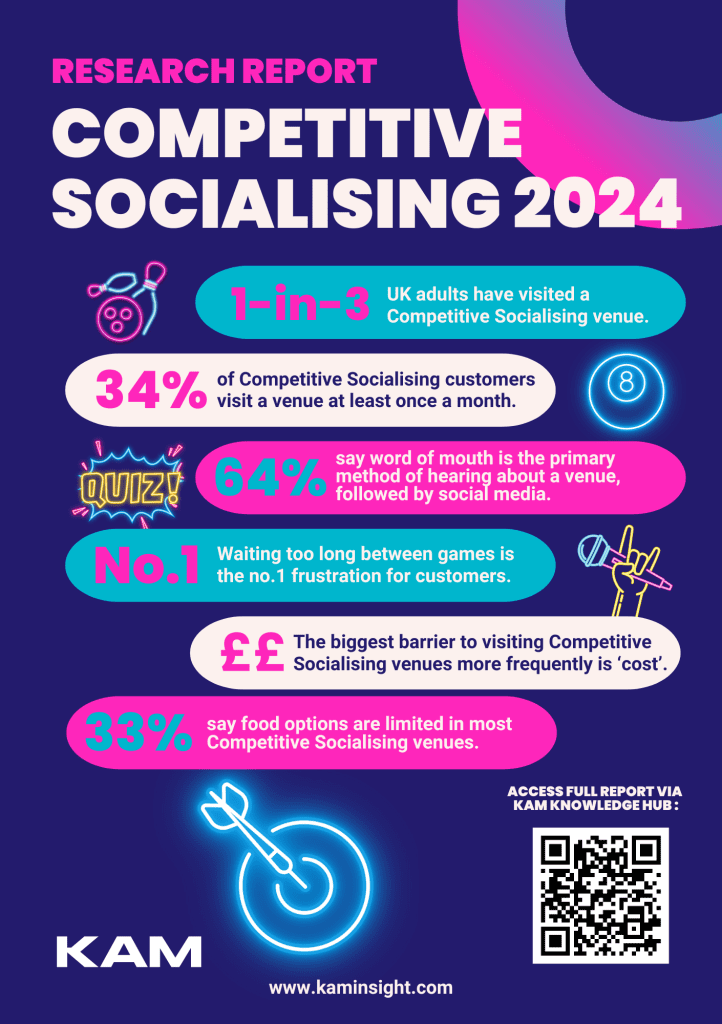Competitive Socialising is a key growth area for the industry, driven by consumer demand for novel and engaging ways to connect with others, these venues are reshaping the landscape of social entertainment, and with it, the UK hospitality sector.
New research from international real estate advisor Savills, shows that the Competitive Socialising sector has grown at unparalleled levels over the past five years – with a 38% uptick in venues since 2018. That’s pretty impressive.
But who exactly is using these often very unique venues?
The customer profile of these ‘activity-led’ venues is markedly different to the typical UK Pubs & Bars, with nearly 60% of spend coming from the 18-to-34-year-old age groups (source: HDI), which is more than twice the level of sales they represent for total hospitality. Young affluent males were the early adopters of Competitive Socialising venues, however, over the last couple of years we have seen share of spend being taken from these customer profiles and increases in females, older demographics and those from medium and low incomes. This suggests a broadening of appeal for Competitive Socialising venues and a nod towards them becoming a more mainstream element of hospitality.
Back in 2022, KAM started researching the Competitive Socialising customer, with the specific aim to understand the attitudes, motivations, behaviours and barriers to their interaction and engagement with the venues. Now into its 3rd iteration, our latest annual research report was launched at ‘The Power of Play & Competitive Socialising Event & Awards’, back in May of this year.
The research was based on 600 UK adults who had visited a Competitive Socialising venue in the last 12 months, and the report provides a flavour of the customer; who they are, why they visit and most importantly identifies opportunities for venues and brands to drive footfall, improve their experience, grow spend and create loyalty.
Three key trends for Competitive Socialising
1. Huge opportunity to capture the ‘casual’ occasion alongside protecting the existing hero occasions, such as celebrations and dates.
Compared to ‘traditional’ pubs, bars and restaurants, Competitive Socialising venues under-index for habitual occasions, such as regular meet-ups with friends/family and after work drinks, yet over-index for celebrations and romantic occasions. The risk is that customers see Competitive Socialising venues as a one-off treat occasion and therefore visit frequency (and repeat visits) will be low. Venues need to consider how they can drive more frequent footfall. Just as the majority of pubs and bars now will have different events and promotions running throughout the weeks, Competitive Socialising venues can’t rely (forever) on the unique appeal of their games alone, if they want customers to return regularly.
2. Food and drink prioritised over entertainment when consumers go out – Competitive Socialising venues need a credible offer in both to ensure that customers don’t ‘cut them out’ of their night out.
If customers were planning a night out with friends and they had a restaurant, a bar/pub and a Competitive Socialising venue lined up but had to cancel one of them, due to a lack of time, which one would they remove from their night out? Unfortunately for us, it’s Competitive Socialising. It’s 5% more likely to get cut for somewhere to go for a drink, but 20% more likely to get cut for somewhere to go for something to eat. Which highlights the opportunity for driving footfall, spend and dwell time by delivering a credible food offer in venues. The top factors that would encourage customers to eat in Competitive Socialising venues are; ‘if the food was better value for money (49%)’, ‘if you could eat sitting down somewhere separate from the games (46%)’, and ‘if the food was better quality (45%)’.
3. Variety is the spice of life when it comes to Competitive Socialising. One game will get customers in once, but multiple games, multiple game-modes and multiple permutations will get them coming back for more and staying longer.
57% of customers say they prefer Competitive Socialising venues with multiple activities, compared with just 17% saying they prefer a venue dedicated to one activity.
Graham Cook, CEO, All Star Lanes
“Adding in activities other than bowling such as nostalgic video games, fairground games like basketball, boxing, whack a mole etc has been brilliant. In some case we have managed to get ROI in as little as 12 weeks. It provided small incremental spends from those already in venue and immediate hits to the bottom line.”
Taking a macro view, the experience economy continues to grow as consumers value experiences over products, driven by numerous factors, including the increased accessibility of experiences and experience-led venues, the rise of social media and the enhancements and proliferation of technology. Competitive Socialising venues are in the sweet-spot of this growing trend; however, they can’t stand still and can’t sustain being a one-trick pony. Customers will try most things once, but the real challenge is getting them to come back again and again.
Understanding who your customers are and (more importantly) what they want is critical in ensuring your business, and the industry, is set up to succeed in the long term.
Access KAM’s latest research into the Competitive Socialising consumer by signing up to our online Knowledge Hub – an Access All Areas pass is just £495 a year giving you access to KAM’s data-led whitepapers, deep-dive research reports, infographics, webinars and opinion.
If you’re interested to access more of our hospitality research in general then take a look at our Knowledge Hub (lots of free insight!)

